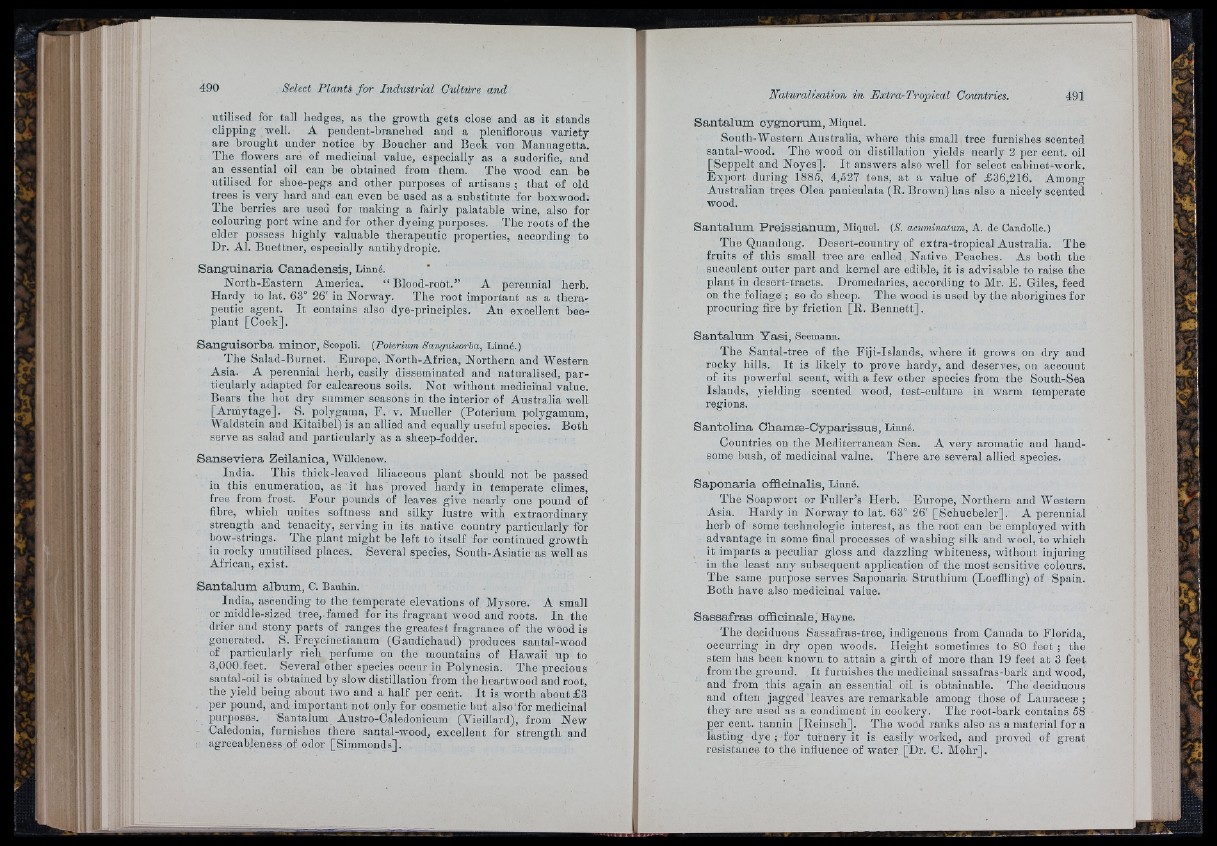
utilised for tall hedges, as the growth gets close and as it stands
clipping well. A pendent-branched and a pleniflorons variety
are brought under notice by Boucher and Beck von Mannagetta.
The flowers are of medicinal value, especially as a sudorific, and
an essential oil can be obtained from them. The wood can be
utilised for shoe-pegs and other purposes of artisans ; th a t of old
trees is very hard and can even be used as a substitute for boxwood.
The berries are used for making a fairly palatable wine, also for
colouring port wine and for other dyeing purposes. The roots of the
elder possess highly valuable therapeutic properties, according to
Dr. Al. Buettner, especially antihydropic.
Sanguinaria Canadensis, Linué.
North-Eastern America. “ Blood-root.” A perennial herb.
Hardy to lat. 63° 26' in Norwaj». The root important as a therapeutic
agent. I t contains also dye-prinoiples. An excellent bee-
plant [Cook].
Sanguisorba minor, Scopoli. {Potermm Sanguisorba, Linné.)
The Salad-Burnet. Europe, North-Africa, Northern and Western
Asia. A perennial herb, easily disseminated and naturalised, p a rticularly
adapted for calcareous soils. Not without medicinal value.
Bears the hot dry summer seasons in the interior of Australia well
[Armytage]. S. polygama, F. v. Mueller (Poterium polygamum,
Waldstein and Kitaibel) is an allied and equally useful species. Both
serve as salad and partioularly as a sheep-fodder.
Sanseviera Zeilanica, Willdenow.
India. This thick-leaved liliaceous plant should not be passed
in this enumeration, as it has proved hardy in temperate climes,
free from frost. Four pounds of leaves give nearly one pound of
fibre, whicli unites softness and silky lustre with extraordinary
strength and tenacity, serving in its native country particularly for
bow-strings. The plant might be left to itself for continued growth
in rocky unutilised places. Several species. South-Asiatic as well as
African, exist.
Santalum album, C. Bauhin.
India, ascending to the temperate elevations of Mysore. A small
or middle-sized tree,-famed for its fragrant wood and roots. In the
drier aud stony parts of ranges the greatest fragrance of the wood is
generated. S. Freycinetianum (Gaudichaud) produces santal-wood
of particularly rich perfume on the mountains of Hawaii up to
3,000 feet. Several other species occur in Polynesia. The precious
santal-oil is obtained by slow distillation from the heartwood and root,
the yield being about two and a half per cent. I t is worth abont £3
per pound, and important not only for cosmetic but also Tor medicinai
purposes. Santalum Anstro-Caledonieum (Vieillard), from New
Caledonia, furnishes there santal-wood, excellent for strength and
agreeahleness of odor [Simmonds].
Santalum cygnorum, Miquel.
South-Western Australia, where this small tree furnishes scented
santal-wood. The wood on distillation yields nearly 2 per cent, oil
[Seppelt and Noyes]. I t answers also well for select cabinet-work.
Export during 1885, 4,527 tons, a t a value of £36,216. Among
Australian trees Olea paniculata (R. Brown) has also a nicely scented
wood.
Santalum Preissianum, Miquel. (S. acuminatum, A. de Candolle.)
The Quandong. Desert-country of extra-tropical Australia. The
fruits of this small tree are called Native Peaches. As both the
sucoulent outer part and kernel are edible, it is advisable to raise the
plant in desert-tracts. Dromedaries, aecording to Mr. E. Giles, feed
on the foliage ; so do sheep. The wood is used by the aborigines for
procuring fire by friction [R. Bennett].
Santalum Yasi, Seemann,
The Santal-tree of the Fiji-Islands, where it grows on dry and
rooky hills. I t is likely to prove hardy, and deserves, on account
of its powerful scent, with a few other species from the South-Sea
Islands, yielding scented wood, test-culture in warm temperate
regions.
Santolina Ohamee-Cyparissus, Linné.
Countries on the Mediterranean Sea. A very aromatic and handsome
bush, of medicinal value. There are several allied species.
Saponaria offlcinalis, Linné.
The Soap wort or Fuller’s Herb. Europe, Northern and Western
Asia. Hardy iu Norway to lat. 63° 26' [Schuebeler], A perennial
herb of some technologic interest, as the root can be employed with
advantage in some final processes of washing silk and wool, to which
it imparts a peculiar gloss and dazzling whiteness, without injuring
in the least any subsequent application of the most sensitive colours.
The same purpose serves Saponaria Struthium (Loeiiiing) of Spain.
Both have also medicinal value.
Sassafras offloinale, Hayne.
The deciduous Sassafras-tree, indigenous from Canada to Florida,
occurring in dry open woods. Height sometimes to 80 feet ; the
stem has been known to attain a girth of more than 19 feet at 3 feet
from the ground. I t furnishes the medioinal sassafras-bark and wood,
and from this again an essential oil is obtainable. The deciduous
and often jagged leaves are remarkable among those of Lauraoeae ;
they are used as a condiment in cookery. The root-bark contains 58
per cent, tannin [Reinscli]. The wood ranks also as a material for a
lasting dye ; for turnery it is easily worked, and proved of great
resistance to the influence of water [Dr. C. Mohr].